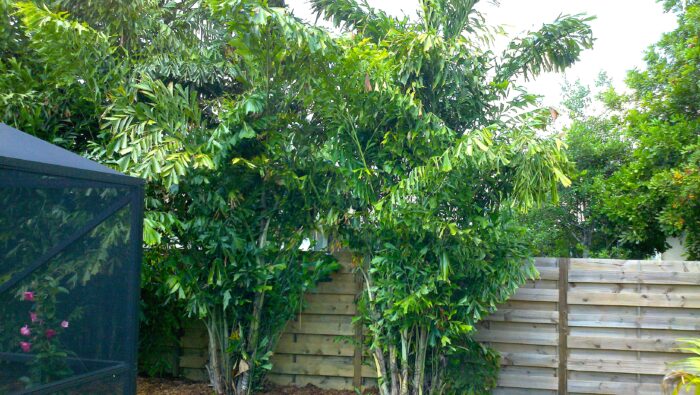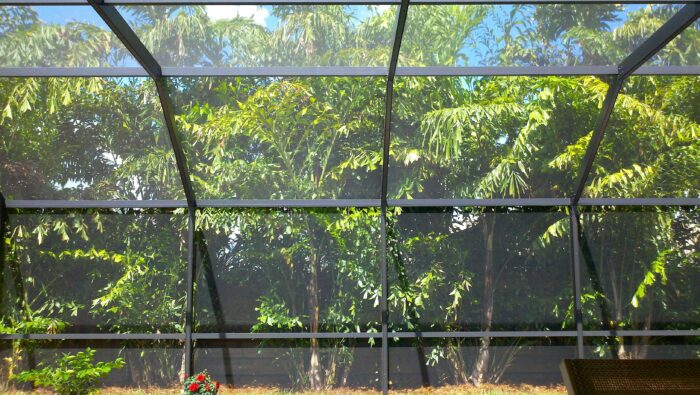Fishtail palms planted in right spot will have you hooked.
Fishtail palms in Sarasota do swimmingly well in landscapes with no space constraints. But plant them in a tight little area and you’ll have a whale of a time controlling their growth. No, they’re not invasive. They just like to grow! Properly placed, your fishtails will serve as a unique privacy screen unlike ubiquitous bamboos and areca palms. ArtisTree’s Plantopinions experts cast their votes for fishtails, with all five judges giving a thumbs-up splashed with a few caveats.
Joe Mantkowski, VP Landscape Design, thumbs up:
Fishtail palms are a nice choice for screening/buffering, but I only use in coastal areas since they’re not cold tolerant. They’re a great tropical option to the areca palm that’s more widely used. What I like about this palm is that whether starting small or large, the foliage has a cool texture/look about it, is nearly full to the ground, and grows at a moderate rate. You can also selectively prune off any of the trunks near the ground to control the height and spread. Just have to keep an eye on it, that’s all.
Clinton Lak, Landscape Designer, thumbs up:
Fishtail palms create a great large tropical screen where space constraints aren’t an issue. A nice characteristic is that they don’t turn yellow in the full sun like areca palms. This tropical plant is best suited to the warmer regions of our range in places where a 20-to 30-foot screen is required. They work great on properties that are “built-up” (off of flood level) and/or homes that are two and three stories in height. Don’t recommend them for small lots since their mature size is often far larger than the site can accommodate. Please note: If you do your own landscape maintenance, it’s critical to know that these palms contain calcium oxalate crystals — tiny spines that can cause itching and a burning sensation. These crystals are particularly concentrated in the plant’s seed pods, which, while not lethal, can cause significant discomfort. I unfortunately found out the hard way and compare the sensation to rolling around in fiberglass insulation. It takes a bit of time for the sensation to set in and seems to intensify with itching.
Chris Culp, Landscape Designer, thumbs up:
I once showed a photo of a fishtail palm to one of my clients and she thought all the fronds were damaged. But that’s what gives this palm such a unique look. The leaf blades have divided segments that resemble a fish tail, hence the name. It’s a cool palm in the Arecaceae family and does great in zones 10B through 11. I especially like how the branches don’t droop. You don’t have to prune much other than trim the smaller trunks to keep the integrity of the bigger ones. Also, as each stalk gets older, it will flower/seed out and die. The fishtail is a nice upright palm that’s great for screening purposes.
Brian Clouser, Landscape Designer, thumbs up:
I think fishtail palms are OK – have nothing really negative or positive to say about them. Just don’t keep them too wet (like everything else). They make a good green screen but will need plenty of space to look their best. You’ll see them used like areca palms and clumping bamboos, offering nice dense privacy. They have an interesting spiral leaf arrangement that spreads to 15 feet and reaches to 30 feet. Maintenance is needed just like it’s needed for arecas and bamboos. Allow a few new shoots to grow to replace the older trunks. This will keep them looking healthy and vigorous.
Elisabeth Owen, Landscape Designer, thumbs up:
I haven’t used many fishtail palms due to their large size, but they’re definitely beautiful and serve a purpose. They’re best used when a tropical look is desired and there’s ample space. For instance, you can install them along your property boundary to screen away neighbors (just make sure there are no power lines or competing canopy trees and there’s room for their 10-foot-wide span). For the average one-story home, this multi-clumping palm will grow very large and not be in scale. Have an extra-tall pool cage? They look fabulous in a dressy pot. I’ve also seen them inside spacious resorts and hotel lobbies. They’ll grow in full sun or part shade, or even in bright, filtered light. A note: bamboo or areca palm will achieve similar results and unlike fishtails, they’re self-cleaning. Plant fishtail palms in a well-drained location and fertilize with a complete palm fertilizer three times annually.
Conan Michel, Operations Manager, thumbs up:
I like the fishtail palm … in the right location. The variety we use most here in South Florida is the Caryota Mitis, which is a multi-stem clustering palm. It serves as an excellent, vertical privacy hedge growing up to 30 feet. Fishtails are often used on multi-level home properties to block neighboring views. You’ll also see them used as privacy hedges for beach homes and on smaller lots with bigger, multi-story homes. On the downside, fishtail palms can grow too big for an area where a smaller hedge would be a better choice. They do require pruning to continue to look clean, especially since stems die after flowering and need to be removed. The remaining stems in the cluster will continue to grow. Fronds that brown have to be pruned off. Very important: This palm can irritate your skin. The seeds contain oxalic acid, which causes burning and itching. A great palm when planted in the right location!

ArtisTree “Plantopinions” is a roundtable debate between multiple ArtisTree experts on the virtues of various plant specimens. Sometimes there’s consensus and sometimes not. In the end, you are the judge!
Contact ArtisTree Landscape 941.488.8897

To get your landscape renovation started now, browse ArtisTree’s portfolio and then call Jenni Lassen at 941.488.8897 to meet with one of our award-winning designers. We proudly serve Sarasota, Manatee and Charlotte counties.
ArtisTree also provides complete landscape maintenance services for HOA communities throughout Southwest Florida. Contact Michael Casper at 941.488.8897 for your custom proposal.
Tagged with: ArtisTree Landscape, Sarasota HOA landscape maintenance






